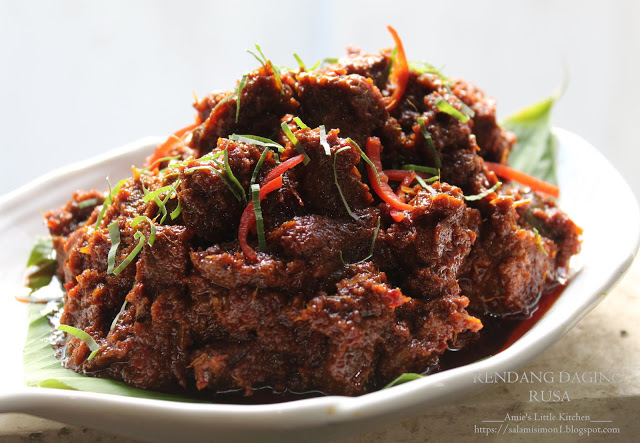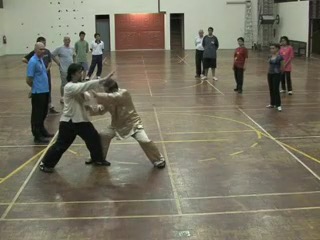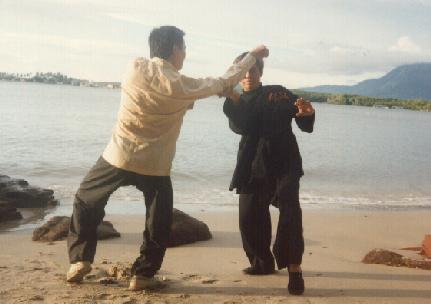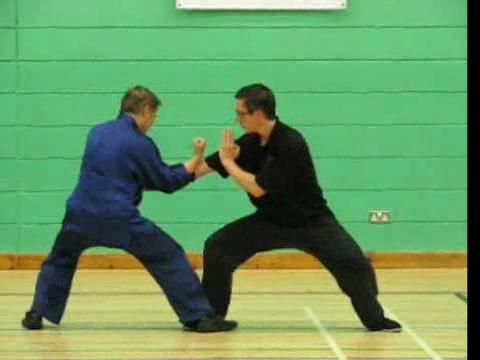SELECTION OF QUESTIONS AND ANSWERS
JULY 2021 PART 2

Rendang daging, or beef rendang, photo taken from https://salamisimon1.blogspot.com/2019/05/rendang-daging-rusa.html
Question 1
I hope you and Simu are doing well! Everyone in my family is doing well.
Since Idi and I have been spending more time at home, we have been cooking a lot more. One of the meals that I have been craving and reminds of Malaysia is beef rendang.
I remember you mentioning that it is one of your favorite dishes. And if I am not mistaken, Simu makes a very nice beef rendang. Do you think Simu would kindly share her recipe if she has one?
— Sifu Eugene Sitamen, Chief Instructlor of Shaolin Wahnam USA
Answer
It is wonderful to hear from you. I always remember you as a capable person managing your father's multi-million dollar business. It has been some time since we were together.Another incident I am very proud of was your mother cooking me and Chun Nga a delicious breakfast. Still another incident was your father telling me that his knee pain was washed down like a flush in Scotland.
I am very happy that Idi and you are happily married. It is lovely that she cooks you "beef rendang". I shall ask Simu when she wakes up. I wake up very early while she is still sleeping.
"Beef rendang" is my favorite dish. I remember I took "beef rendang" in a shop in Kulim, a town from Sungai Petani about 30 years ago. (Both Kulim and Sungai Petani are in Kedah, Malaysia.) The shop is still there but it is no longer selling "beef rendang" and the hawker is nowhere to be seen. It was "Nasi Sumatra", which means "Sumatran Rice".
Another place I remember having "beef rendang" was in Sabah when Damian and Roseline took me for a drive. It is quite far from Kinabalu National Park where we have our Sabah courses. It is also very kind of Damian and Roseline to have "beef rendang" with me in the same table when they are both vegetarian.
Question 2
My following questions are based on the following picture series.
1. What is the difference between Green Dragon Returns Head (Pattern 24) and Level Sand Descends Drake (Pattern 69)?
2. What is the difference between Green Dragon Turns Body (Pattern 12) and Green Dragon Starts Dancing (Pattern 45)?
3. What is the difference among these three similar patterns: Point to Star Look at Moon (Pattern 35), Dark Dragon Wags Tail (Pattern 55), and Green Dragon Spreads Tail (Pattern 82)?
— Sifu Leonard Lackinger, Shaolin Wahnam Wien
Answer
The Traveling Dragon Sword is my favorite weapon. My second favorite weapon is the Flowing Water Staff which I learned from Sifu Ho Fatt Nam.
The sword was the favorite weapon of kungfu knights. The favorite weapon of Shaolin Kungfu is the staff.
As I did not learn any sword set from my sifus, I composed my own set using whatever material I could get, including films showing the sword applications. Three favorite sword sets that influenced me most were the Traveling Dragon Sword, the Bodhidharma Sword and the Wudang Sword. Much later I composed the Wudang Sword set.
Regarding your questions concerning the picture series, here are my answers:
1. Difference between "Green Dragon Returns Head" and "Level Sand Descends Drake":
"Green Dragon Returns Head" is slightly higher, it is more horizontal, and the target is the opponent's wrist. "Level Sand Descends Drake" is slightly lower, it is more vertical, and the target is the opponent's body. However, in combat application we can make whatever modification when necessary. This principle applies whatever combat applications are involved.
2. Difference between "Green Dragon Turns Body" and "Green Dragon Starts Dancing":
They are quite similar. It is a case of different names for the same pattern.
3. Difference among three similar patterns:
The three patterns, "Point to Star Look at Moon", "Dark Dragon Wags Tail", and "Green Dragon Spreads Tail", are quite different, though they use the Unicorn Stance and the Stolen Stance, which is the reverse of the Unicorn Stance.
"Point to Star Look at Moon" often uses the Stolen Stance. If your right leg is forward, you move your left leg forward past your right knee. The movement of the sword is diagonally upwards. If an opponent is piercing you with his spear at your head, you move forward and slice his wrist or arm with your sword in the Stolen Stance.
In "Dark Dragon Wags Tail", after meeting an opponent in front like "Receive Wind Wave Fan" in the example, you turn around letting your opponent chase after you, use your right leg to cross over your left leg in the Unicorn Stance, and use your sword to slice the opponent's body upwards, sometimes diagonally.
In "Green Dragon Spreads Tail", you tempt the opponent to chase after you. You turn around, cross your right leg over your left leg in a Unicorn Stance, and use your sword to sweep diagonally at the opponent's body. Sometimes you may use the Stolen Stance if you move forward to sweep at your opponent.

Question 3
Do you have any suggestions on practicing combat applications while being home alone, for beginning, intermediate and advanced students?
Answer
The combat applications are some of my best inventions. I don't know how I came out with them; it must be divine guidance. They speed up combat applications using kungfu techniques from about three years to a year, which is quite fast, considering that kungfu applications are sophisticated. Most kungfu practitioners, including "masters", cannot use their kungfu for combat.
For beginning Shaolin students, who actually have been in our school for some time, they learn 16 Basic Shaolin Combat Applications. For Taijiquan students, they learn 12 Basic Taijiquan Combat Sequences.
For intermediate Shaolin students, they learn 8 Distilled Shaolin Combat Sequences. For intermediate Taijiquan students, they learn 8 Distilled Taijiquan Combat Sequences.
For advanced Shaolin students, they learn 4 Abridged Shaolin Combat Sequences. For advanced Taijiquan students, they learn 4 Abridged Taijiquan Combat Sequences.
For intermediate and advanced students, they should know why the combat sequences are distilled and abridged.
Question 4
It has been a while. I hope you and your family are keeping well and safe.
I was speaking to Eugene a few weeks ago, I have been out of touch with some of the changes that have gone on in our Wahnam school. Eugene was kind to provide me with a bit of an update.
— Andrea, Canada
Answer
I have always thought fondly of the time when we were in New York where you, me and Eugene were there in the Asia Society Meeting when I rolled on the floor, jumped down and up again to show that we were agile. I also remember that you saw a famous grandmaster who passed away on this earth but later you saw him so clearly, and he taught you the tiger-claw which was his specialty.
Eugene is a lovely boy, and I miss him very much.
I must share with you a saying that "if we are accomplished in the Shaolin arts, it is better than changing stones to gold by touch." At first I thought it was much exaggerated, but gradually I realize its truth, especially now when we have a world lockdown. It is a good prevention against any virus, any disease, and we are not carriers as the virus is destroyed immediately.
It is even better when we practice kungfu. It gives us even more good health, vitality. longevity, peak performance and spiritual joys irrespective of religion.

An application of the Tiger-Crane Set
Question 5
I have always been drawn to the Tiger Crane style. I have been thinking about this. A monkey and a tiger are conflict animals in Chinese astrology. If I am a monkey is it wrong to specialize in the Tiger Crane style?
Answer
I believe the Tiger-Crane style is excellent for you. I started with 36 patterns, then 72 patterns of Choe Family Wing Choon. I learned the 108 patterns later. Actually I can't remember whether I learned the 72-pattern or the 108-pattern set earlier.
The Monkey Set was the specialty of my sifu, Sifu Ho Fatt Nam. I also learned the Monkey set indirectly from another master. When I taught the Monkey Set in Finland, I combined the two sets into one.
It is not necessary to follow Chinese astrology when specializing a set.
Question 6
The Shaolin Chi Kung, Shaolin Kung Fu and Tai Chi Chuan you taught us are truly a treasure. I practice Chi Kung every day as it certainly brings one joy and happiness.
Answer
Our chi kung is very high-level. Most people only practice gentle, physical exercise though they call it "chi kung". Some, less than 20%, practice low levels chi kung, and amongst a very few of them become masters after many years.
Kungfu -- genuine Kungfu, not demonstrating forms or can't use kungfu techniques for combat -- is even better.

A pattern from "Four Gates", using just one hand in combat
Question 7
I asked this many years ago and I do not wish to be disrespectful but in Kung Fu we practice our sequences only on one side. I remember you said that you were taught from your Sifu this way. Do you believe this is a weakness in our school?
Answer
I remembered asking my sifu, Sifu Ho Fatt Nam, whether we should practice both sides to have balance. My sifu told me that it was not necessary. When we practice Shaolin Kungfu, especially "Four Gates", we use only one side. We use the other side, the left side for most people, to control our opponents.
But if you practice other styles of kungfu, even Taijiquan which is quite extensive, you can use both sides. In our Shaolin Wahnam version of the 108-Pattern of Yang Style Taijiquan, we use both sides because I find that the orthodox version uses only one side. Wudang Taijiquan, however, uses only one side.
Question 8
I recall several years ago when we were in Costa Rica, you discussed that a master could develop a crystal in their Dan Tian.
Answer
If you stand upright and be relaxed, you will naturally focus your "chi" (or energy) at your "dan tian". Hence the "dan tian" is considered the natural energy field.
I believe that great monks develop "relics" at their "dan tian". The "relics" of the Buddha and other great monks were considered national treasures.
If you have any questions, please e-mail them to Grandmaster Wong via his Secretary at stating your name, country and e-mail address.
LINKS
Selected Reading
- Ten Most Delicious Types of Food in my World Travels
- The Marvelous Sword against the King of Weapons
- Combat Sequences of Tiger-Crane Set
- Cultivating Spirit Training Energy
- Enchanting Riverside at St Antonio
